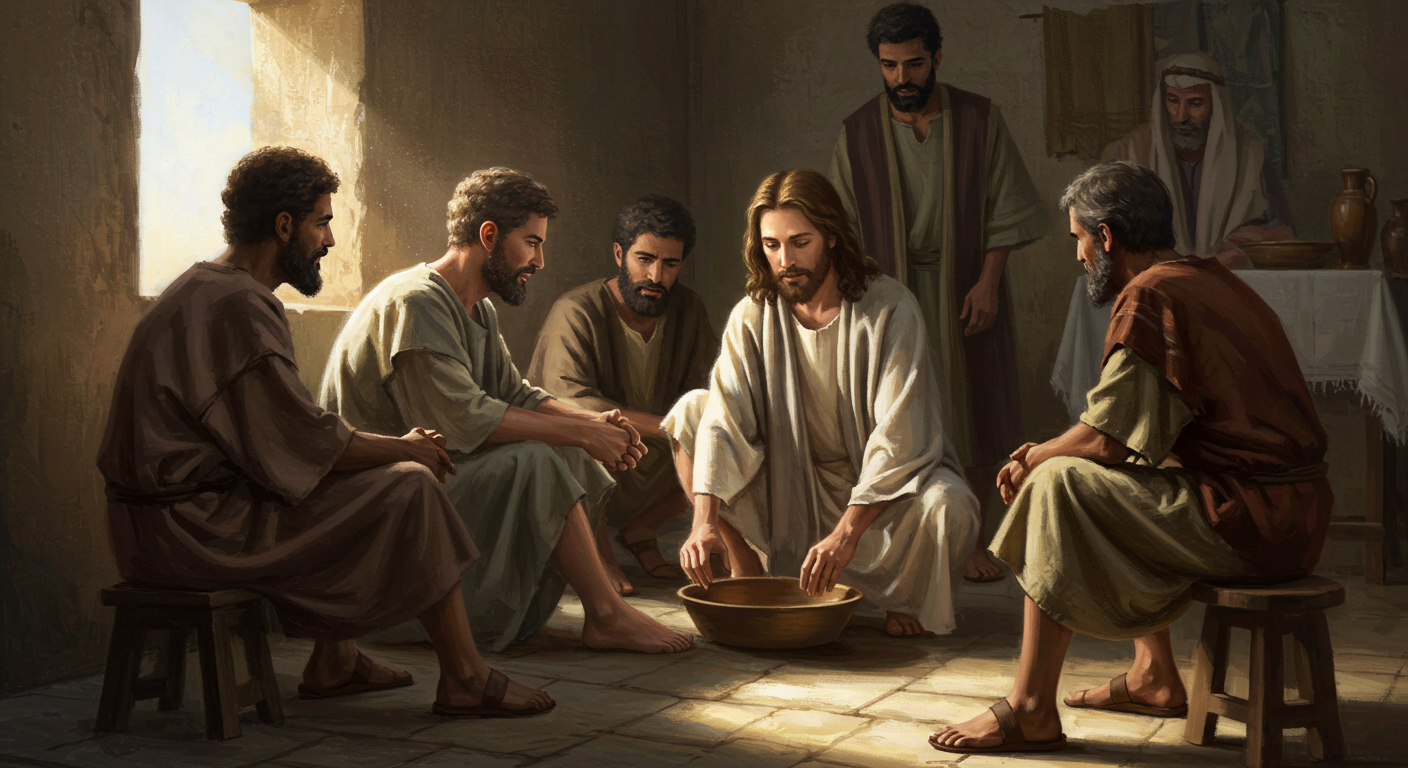How Jesus Showed Us To Serve Others
You probably already know that Jesus didn’t just teach service—He modeled it. When you look at Jesus serving others, you see more than occasional acts of kindness; you see a whole life shaped around compassion, humility, and sacrificial giving. That pattern becomes your blueprint for serving in everyday life: how you treat neighbors, lead teams, love enemies, or stop to listen to someone who’s hurting. This article walks through concrete moments from Jesus’ life, Scripture-backed lessons, and practical steps so you can follow that example more intentionally.
Jesus as the perfect model of service
When you read the New Testament, the portrait of Jesus is unmistakable: servant, teacher, healer, and sacrificial friend. Paul captures it powerfully when he urges you to have the same mindset as Christ—who “made himself nothing” and humbled himself to the point of death on a cross. That passage shows you that service isn’t a tactic; it’s rooted in self-emptying love and humility Philippians 2:5-8. If you want to learn how to serve, start here: by following someone whose whole life was oriented toward others.
The example of humble service: washing the disciples’ feet
One of the clearest demonstrations of Jesus serving others is the foot washing at the Last Supper. In that moment, He stooped, literally, and took on the role of a servant—washing dusty, tired feet that had been following Him for years. This wasn’t just a practical act; it was a teaching moment about the posture of the kingdom John 13:1-17. When you picture Jesus serving others, this scene keeps you from confining service to grand gestures; it reminds you that humility often looks small and inconvenient.
What did the foot washing teach you?
From that act, you learn several practical lessons: humility is countercultural, leadership looks like serving, and dignity is restored when a leader chooses lowliness. Jesus tells you explicitly to follow His example: if He, your Lord and Teacher, washed feet, you should wash one another’s feet John 13:14-15. So your day-to-day service may include “low” tasks—listening to the tired, bearing a burden for a coworker, or doing unseen work—that actually embody the heart of the gospel.
Jesus serving others through healing and compassion
A big part of Jesus serving others shows up in His ministry of healing and compassion. Whether it’s touching lepers, restoring sight to the blind, or raising the dead, Jesus met people where they were—with their pain, shame, and physical needs. The Gospels are full of stories that show you how compassion propels action: He felt compassion, and then He moved to heal or feed or comfort Mark 1:40-45, Mark 5:25-34, John 11:1-44.
The miracle of compassion that moves you to act
When you see Jesus serving others by healing, it’s more than wonder; it’s a model of responsive love. He doesn’t wait for perfect conditions. He intervenes where there’s hurt. That invites you to be attentive: notice suffering, let compassion grow into action, and don’t assume someone else will handle it. Compassion is not only an emotion; in Jesus’ life, it’s practical and kinetic.
Serving the marginalized and outcasts
Jesus had a pattern: He drew near to those whom society pushed away—tax collectors, lepers, women of questionable reputations, Samaritans. You see Him dining with Zacchaeus Luke 19:1-10, engaging the Samaritan woman at the well John 4:1-42, and defending the outcast who was about to be condemned John 8:1-11. In every story, Jesus serving others flips cultural norms: the excluded are invited in and the shamed are restored.
Lessons on inclusion and dignity
For your life, that means serving isn’t just meeting needs; it’s restoring dignity. When Jesus serves the marginalized, He reassigns social value: worth isn’t based on status but on image-bearing and grace. You’re invited to act the same way—advocate for the overlooked, include the lonely, and treat others as image-bearers, even if society discounts them. The parable that drives this ethic home is the call to care for “the least of these” as serving Christ Himself Matthew 25:35-40.
Servant leadership: Jesus’ leadership model
If you’re in any leadership role, pay attention: Jesus redefined power. When His disciples argued about who would be greatest, Jesus set a new standard: greatness is service. A leader seeks to serve, not to be served. That teaching is straightforward: “Whoever wants to be first must be slave of all” Mark 10:42-45. That flips your instinct to climb the ladder or protect your status. Jesus serving others means you lead by serving.
How you can lead like Jesus
Lead by listening, by doing the tasks you ask others to do, and by making decisions that prioritize the welfare of those you lead. Clear examples from Jesus’ life include sacrificial time investment, personal presence with people in hardship, and teaching that equips others rather than elevates the leader. When you put these into practice, you model a Jesus-shaped leadership that cultivates trust and empowers others.
Sacrificial service: the cross as ultimate service
If the other examples teach you about humility and compassion, the cross shows you the extent of Jesus serving others. The ultimate act of service is laying down your life for your friends—something Jesus declared as the defining measure of love, John 15:13. His death isn’t merely a theological event; it’s the greatest demonstration of service—the giving of oneself to secure the good of others. Paul returns to this theme when he describes Jesus’ humility and obedience to death Philippians 2:5-8.
Serving in costly ways
You’ll rarely be called to martyrdom, but you will be invited to costly service—sacrifices of time, comfort, reputation, and resources. The cross teaches you to evaluate service by cost and motive: are you serving to gain praise, or are you willing to be inconvenienced for the good of another? Jesus serving others challenges you to embrace costly love.
Serving through teaching and equipping others
Jesus didn’t only do; He trained. His teaching invited people into a way of life—He told stories, answered questions, and sent the disciples out to practice what they learned. When you think of Jesus serving others, remember that He served by equipping people to serve as well. The Great Commission sends you to teach and make disciples Matthew 28:18-20, and Jesus’ new commandment to love one another equips you to be a community that serves John 13:34-35.
The role of mentorship and discipleship
Serving like Jesus includes pouring into people—mentoring, correcting with love, and helping others develop spiritual and practical skills. You serve not just by doing for people but by building capacity in them. This multiplies service and creates resilient communities.
Service in ordinary acts: hospitality, feeding, listening
Some of the simplest acts are the most frequent examples of Jesus serving others. He fed crowds, hosted people, sat at meals with sinners, and spent time with the lonely. The feeding of the five thousand is a big, public sign of care Matthew 14:13-21, but He also modeled private hospitality and attentive presence. These ordinary acts are the fabric of service in daily life—sharing a meal, opening your home, making time to listen to someone who needs to talk.
Small acts with big impact
When you apply this, know that consistency matters. Doing small things—calling an elderly neighbor, offering coffee to a coworker, making space for a friend’s tears—builds a culture of care. Jesus serving others shows you that these small, repeated acts shape lives over time.
Serving enemies and radical love
One of the most counterintuitive elements of Jesus’ example is serving those who oppose you. Jesus said Love your enemies and pray for those who persecute you Matthew 5:43-48. That command isn’t abstract; it’s intensely practical. When you return kindness for animosity, you break cycles of revenge and model a transformative way of living.
Practical ways to serve those who hurt you
Serving enemies could mean responding with forgiveness, advocating for fair treatment, or offering practical help where possible. That doesn’t mean allowing abuse; rather, it’s a posture of redemptive love that seeks the good of the other while maintaining healthy boundaries. Jesus serving others invites you to pursue reconciliation where safe and possible.

Parables and teachings that shaped servant-hearted living
Jesus often used stories to teach what serving looks like. Parables like the Good Samaritan make service tangible and confront your assumptions about neighbor and obligation Luke 10:25-37. These stories press you to live an ethic of mercy rather than mere religious observance.
How these stories shape your practical choices
These parables shift your imagination. They make you ask: Who is my neighbor today? Where is the need when I walk past it? The Good Samaritan asks you to cross ethnic and social boundaries to care for someone in crisis—a clear, everyday invitation to embody Jesus serving others.
The rhythms and habits that help you serve consistently
It’s one thing to admire Jesus’ acts; it’s another to cultivate a life that follows them. Jesus had rhythms—prayer, solitude, community, mission—that sustained His ministry Mark 1:35. If you want to serve well, you need similar practices that fuel you: spiritual formation, healthy rest, regular evaluation of motives, and community accountability.
Practical habits to grow in serving others
- Make prayer and reflection a daily habit so service flows from dependence, not performance.
- Practice small acts of hospitality weekly.
- Create margin in your schedule to respond to needs without rushing.
- Join a community where service is practiced and taught.
These habits help you serve sustainably, reflecting Jesus serving others in ways that don’t burn you out.
Obstacles to serving and how Jesus addresses them
You’ll face real barriers: pride, busyness, fear of being used, and desire for recognition. Jesus’ teachings anticipate and correct these. He warns against doing good for outward applause Matthew 6:1-4, and He constantly reframes greatness as humility Mark 9:33-35. Recognizing these obstacles helps you adjust your heart and your practices—serving others out of love and obedience, not for status.
What to do when serving becomes a duty, or pride creeps in
When serving feels like duty or when you notice pride, return to the cross: meditate on Christ’s humility and sacrifice Philippians 2:5-8. Reconnect with a community that will speak truth into your life, and find ways to serve anonymously when you need to check your motives Matthew 6:3-4. Jesus serving others was often hidden as much as public; follow that balance.
The motivation for serving: love and witness
Jesus serving others was driven by love for the Father and for people, and that same motivation should shape you. He tells you to love one another as He loved you John 15:12, which grounds service not in obligation but in relationship. Service is also witnessed: the way you love one another shows the world who Jesus is John 13:34-35. Your acts of service testify to your faith and create openings for the gospel.
Balancing motivation and reward
It’s okay to notice the fruit of serving—healing, reconciliation, a community transformed—but don’t make that your primary reward. Jesus serving others points you to a deeper reward: intimacy with God and the joy of joining in His redemptive work Matthew 25:21. Let the relationship with the Father and love for neighbor be your core motivators.
Measuring impact without losing the heart of service
You may be tempted to evaluate ministry by metrics: numbers served, dollars spent, programs launched. Jesus gives you a different metric: faithfulness and love. While effectiveness matters, don’t lose sight of whether acts of service reflect Christlike love and humility. Remember that Jesus celebrated faithfulness in small things Luke 16:10.
Accountability and reflection
Set up rhythms to evaluate both outcomes and character. Ask: Did this serve the person’s good? Did it protect dignity? Was my motive love or recognition? Use the community to help you stay honest. Jesus serving others invites you to integrity—a service that looks like Jesus in both action and heart.
Stories from the Gospels that reshape how you serve
Spend time with Gospel stories and you’ll notice recurring themes: personal presence, daring compassion, boundary-crossing love, and sacrificial giving. Each story teaches you a facet of service:
- Feeding the five thousand models practical provision and dependence on God Matthew 14:13-21.
- The woman who touched Jesus’ cloak shows faith’s role in healing Mark 5:25-34.
- The Good Samaritan challenges you to risk time and expense to help strangers, Luke 10:25-37.
These stories aren’t just historical; they’re rehearsals for your daily choices.
Bringing it home: simple practices to keep Jesus serving others at the center
If you’re wondering what to do tomorrow, start small and be intentional. Choose one of these practices to try this week and see how it shifts your outlook:
- Spend 10 minutes in the morning asking God to show you one person to serve that day.
- Invite someone lonely to share a meal.
- Practice listening without offering a solution—presence is service.
- Volunteer for a task that is inconvenient and anonymous.
These practices help you internalize the posture Jesus modeled—so serving becomes not just an action but a lifestyle.
Final reflections: a life shaped by service
When you look closely at Jesus serving others, you don’t just get a list of activities—you get a reorientation of life. He teaches you that true greatness is measured by love, that authority is exercised by service, and that the truest identity you have is as a beloved one who can give love away. Try to let those truths guide your habits, choices, and relationships. As you do, you’ll find serving becomes less of a duty and more of a joy—a way to participate in the work of God in the world.
Explore More
For further reading and encouragement, check out these posts:
👉 7 Bible Verses About Faith in Hard Times
👉 Job’s Faith: What We Can Learn From His Trials
👉 How To Trust God When Everything Falls Apart
👉 Why God Allows Suffering – A Biblical Perspective
👉 Faith Over Fear: How To Stand Strong In Uncertain Seasons
👉 How To Encourage Someone Struggling With Their Faith
👉 5 Prayers for Strength When You’re Feeling Weak

📘 Jesus and the Woman Caught in Adultery – Grace and Mercy Over Judgement
A powerful retelling of John 8:1-11. This book brings to life the depth of forgiveness, mercy, and God’s unwavering love.
👉 Check it now on Amazon
🌍 “Every great message deserves a home online.”
Don’t let your calling stay hidden. Start a Christian Blog/Website using Hostinger — with 99.9% uptime, free domain, and SSL, your voice can shine for God’s glory anytime, anywhere.
👉 Begin today. Try it RISK-FREE!
“Your body is God’s temple — care for it with purpose.”
Renew your energy and restore balance the natural way. Mitolyn helps support a healthy metabolism, giving you the vitality to live out God’s calling with strength and confidence.
🌿 Unlock Your Metabolic Power. Burn More Calories & Feel Great With Mitolyn.
👉 Start Today. Check Price Now.
As a ClickBank & Amazon Affiliate, I earn from qualifying purchases.
Acknowledgment: All Bible verses referenced in this article were accessed via Bible Gateway (or Bible Hub).
“Want to explore more? Check out our latest post on Why Jesus? and discover the life-changing truth of the Gospel!”





